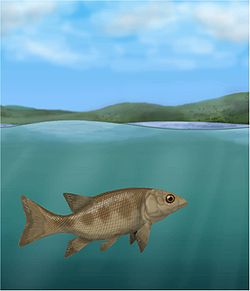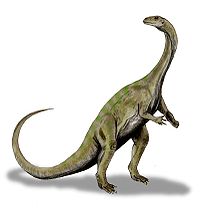
Clarens Formation
Encyclopedia
The Clarens Formation is a prominent fossil site in the Tuli Basin, in the KwaZulu-Natal
region of South Africa
.
KwaZulu-Natal
KwaZulu-Natal is a province of South Africa. Prior to 1994, the territory now known as KwaZulu-Natal was made up of the province of Natal and the homeland of KwaZulu....
region of South Africa
South Africa
The Republic of South Africa is a country in southern Africa. Located at the southern tip of Africa, it is divided into nine provinces, with of coastline on the Atlantic and Indian oceans...
.
Fauna of the Clarens Formation
Unidentified dinosaur eggs have been recovered from the formation.Bony fish
| Bony fishes of the Clarens Formation | ||||||
|---|---|---|---|---|---|---|
| Genus | Species | Location | Stratigraphic position | Material | Notes | Images |
Semionotus Semionotus Semionotus is an extinct genus of ray-finned fish found throughout Northern Pangaea during the late Triassic, becoming extinct at the start of the Jurassic.-External links:... |
S. capensis |
Semionotus ("Flag-Back") is an extinct genus of ray-finned fish found throughout Northern Pangaea Pangaea Pangaea, Pangæa, or Pangea is hypothesized as a supercontinent that existed during the Paleozoic and Mesozoic eras about 250 million years ago, before the component continents were separated into their current configuration.... (North America North America North America is a continent wholly within the Northern Hemisphere and almost wholly within the Western Hemisphere. It is also considered a northern subcontinent of the Americas... and Europe Europe Europe is, by convention, one of the world's seven continents. Comprising the westernmost peninsula of Eurasia, Europe is generally 'divided' from Asia to its east by the watershed divides of the Ural and Caucasus Mountains, the Ural River, the Caspian and Black Seas, and the waterways connecting... ) during the late Triassic Triassic The Triassic is a geologic period and system that extends from about 250 to 200 Mya . As the first period of the Mesozoic Era, the Triassic follows the Permian and is followed by the Jurassic. Both the start and end of the Triassic are marked by major extinction events... , becoming extinct at the start of the Jurassic Jurassic The Jurassic is a geologic period and system that extends from about Mya to Mya, that is, from the end of the Triassic to the beginning of the Cretaceous. The Jurassic constitutes the middle period of the Mesozoic era, also known as the age of reptiles. The start of the period is marked by... . |
 |
|||
Dinosaurs
| Dinosaur Dinosaur Dinosaurs are a diverse group of animals of the clade and superorder Dinosauria. They were the dominant terrestrial vertebrates for over 160 million years, from the late Triassic period until the end of the Cretaceous , when the Cretaceous–Paleogene extinction event led to the extinction of... s of the Clarens Formation |
||||||
|---|---|---|---|---|---|---|
| Genus | Species | Province | Stratigraphic position | Material | Notes | Images |
Aristosaurus |
A. erectus |
|
  |
|||
Fabrosaurus Fabrosaurus Fabrosaurus ) was a genus of herbivorous dinosaur which lived during the Early Jurassic . As the only fossil known of it is a partial jawbone with three teeth, Fabrosaurus is a nomen dubium and may in fact be the same as Lesothosaurus.Fabrosaurus was around 1 meter long... |
Indeterminate |
|
||||
|
Geranosaurus Geranosaurus Geranosaurus is a genus of ornithischian dinosaur from the Early Jurassic. It is known only from a jaw bone and limb elements discovered in South Africa. Because of the limited remains, it is considered a nomen dubium... |
G. atavus |
|
||||
|
Gyposaurus Gyposaurus Gyposaurus is a genus of basal sauropodomorph dinosaur from the early Jurassic of South Africa and China... |
G. capensis |
|
||||
|
Heterodontosaurus Heterodontosaurus Heterodontosaurus is a genus of small herbivorous dinosaur with prominent canine teeth which lived in the Early Jurassic of South Africa. It was similar to a hypsilophodont in shape, and ate plants, despite its canines.Heterodontosaurus is currently known from specimens of the SAFM from South... |
H. tucki |
|
||||
|
Hortalotarsus |
H. skirtopodus |
|
||||
|
Massospondylus Massospondylus Massospondylus and ) is a genus of prosauropod dinosaur from the early Jurassic Period . It was described by Sir Richard Owen in 1854 from remains found in South Africa, and is thus one of the first dinosaurs to have been named... |
M. carinatus |
|
||||
|
Thecodontosaurus Thecodontosaurus Thecodontosaurus is a genus of herbivorous basal sauropodomorph dinosaur which lived during the late Triassic period .... |
T. dubius |
|
||||
|
T. minor |
|
|||||
Synapsids
| Synapsid Synapsid Synapsids are a group of animals that includes mammals and everything more closely related to mammals than to other living amniotes. They are easily separated from other amniotes by having an opening low in the skull roof behind each eye, leaving a bony arch beneath each, accounting for their name... s of the Clarens Formation |
||||||
|---|---|---|---|---|---|---|
| Genus | Species | Location | Stratigraphic position | Material | Notes | Images |
Pachygenelus Pachygenelus Pachygenelus is an extinct genus of tritheledontid cynodont. Fossils have been found from the Karoo basin in South Africa and date back to the Early Jurassic.... |
P. monus |
 |
||||
Tritylodon Tritylodon Trityldon was a genus of tritylodont, one of the most advanced group of cynodont therapsids. They lived in the Early Jurassic and possibly Late Triassic periods along with dinosaurs. They also shared a lot of characteristics with mammals, and were once considered mammals because of overall... |
T. maximus |
Tritylodon was a species of tritylodont Tritylodontidae Tritylodontids were small to medium-sized, highly specialized and extremely mammal-like cynodonts. They were the last family of the non-mammalian synapsids. One of the last cynodont lines to appear, the Tritylodontidae descended from a Cynognathus-like cynodont... , one of the most advanced group of cynodont Cynodont Cynodontia or cynodonts are a taxon of therapsids which first appeared in the Late Permian and were eventually distributed throughout all seven continents by the Early Triassic . This clade includes modern mammals and their extinct close relatives. They were one of the most diverse groups of... s. It was small in size and had an herbivorous diet, something of an anomaly among the mostly carnivorous cynodonts. Tritylodon had many features of modern mammal Mammal Mammals are members of a class of air-breathing vertebrate animals characterised by the possession of endothermy, hair, three middle ear bones, and mammary glands functional in mothers with young... s, but was egg-laying. |
||||

